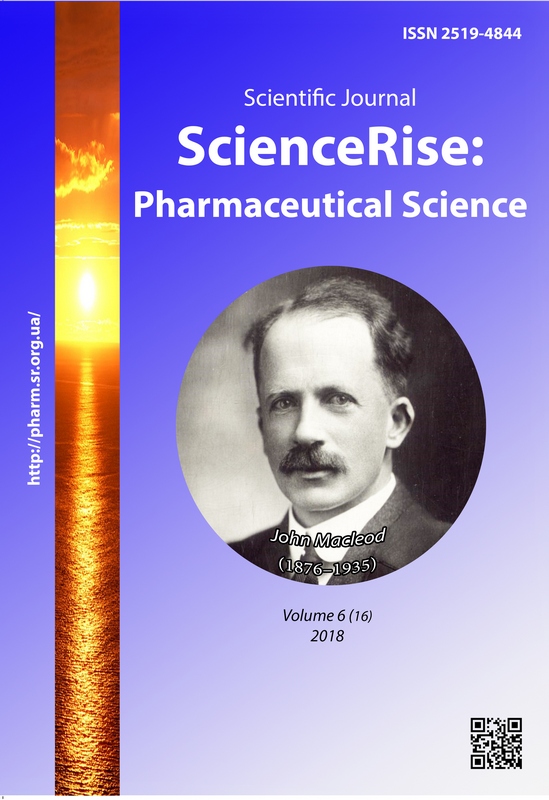Studies on the design of a composition of gel for the treatment of inflammatory diseases of the joints
DOI:
https://doi.org/10.15587/2519-4852.2018.151447Keywords:
combined gel, composition, preservatives, antimicrobial activity, nipagin, technology, inflammation of the jointsAbstract
The aim: the aim of our work was to experimentally substantiate the effectiveness of antimicrobial preservatives in the design of the composition of the combined gel for the treatment of acute and chronic inflammation of the joints.
Methods: biological pharmacopoeial method of research was used (research of the effectiveness of antimicrobial preservatives).
Results. All drugs must meet the requirements of regulatory documents on indicators "Microbiological purity." To ensure the microbiological stability of the preparations, it is necessary to eliminate the factors associated with microbial contamination, therefore we carried out experimental studies on the choice of preservative and its concentration for the developed gel. According to the results of experimental studies on the effectiveness of antimicrobial preservatives in gel samples, the following data were obtained. Samples of the studied gel with sodium preservatives benzoate 0.5 % and nipagin 0.2 % meet the criterion "A" according to the requirements of SPHU for drugs for skin application. But, according to research results, the antimicrobial efficacy of the gel with the preservative nipagin 0.2 % was slightly higher (lg reduction in the number of viable Staphylococcus aureus ATCC 6538 cells was 3.32 and 4.81; Pseudomonas aeruginosa ATCC 9027 - 3.28 and 4.66 ; Candida albicans ATCC 885-653 - 3.50 and 4.09; Aspergillus brasiliensis ATCC 16404 - 3.10 and 4.00 (2 and 7 days, respectively) and the spectrum of antimicrobial action is wider, which will contribute to the quality of the rotated gel also during storage. Therefore, for further research, we will use nipagin 0.2 % as a preservative.
Conclusions: The expediency of using nipagin 0.2 % as a part of a combined gel for the treatment of acute and chronic joint inflammation has been theoretically proved and experimentally proved
References
- Akao, T., Yoshino, T., Kobashi, K., Hattori, M. (2002). Evaluation of Salicin as an Antipyretic Prodrug that does not Cause Gastric Injury. Planta Medica, 68 (8), 714–718. doi: http://doi.org/10.1055/s-2002-33792
- Bisset, N. G. (2004). Herbal Drugs and Phytopharmaceuticals. Stuttgart: Medpharm Scientific Publishers, 534–536.
- Meier, F. M., Frerix, M., Hermann, W., Müller-Ladner, U. (2013). Current immunotherapy in rheumatoid arthritis. Immunotherapy, 5 (9), 955–974. doi: http://doi.org/10.2217/imt.13.94
- Klimes, J., Vocelka, M., Sedova, L., Dolezal, T., Mlcoch, T., Petrikova, A., Vlcek, J. (2014). Medical and Productivity Costs of Rheumatoid Arthritis in The Czech Republic: Cost-of-Illness Study Based on Disease Severity. Value in Health Regional Issues, 4, 75–81. doi: http://doi.org/10.1016/j.vhri.2014.07.004
- Postoi, V. V., Vyshnevska, L. I. (2017). Doslidzhennia z rozrobky skladu heliu dlia likuvannia revmatoidnoho artrytu. Kyiv, 2, 143.
- Postoi, V. V., Vyshnevska, L. I. (2018). The marketing research of the Ukrainian market of drugs for the treatment of arthritis. News of Pharmacy, 1 (93), 38–42. doi: http://doi.org/10.24959/nphj.18.2198
- Derzhavna Farmakopeia Ukrainy (2011). Kharkiv: Derzhavne pidpryiemstvo «Naukovo-ekspertnyi farmakopeinyi tsentr», RIREH, 536.
- Derzhavna Farmakopeia Ukrainy Kharkiv. Vol. 1 (2015). Kharkiv: Derzhavne pidpryiemstvo «Ukrainskyi naukovyi farmakopeinyi tsentr yakosti likarskykh zasobiv», 1128.
- Mirsonbol, S. Z., Issazadeh, K., Pahlaviani, M., Momeni, N. (2014). Antimicrobial efficacy of the methylparaben and benzoate sodium against selected standard microorganisms, clinical and environmental isolates in vitro. Indian Jornal of Fundamental and Applied Life Sciences, 4 (S4), 363–367.
- Stanojevic, D. C. (2009). Antimicrobial effects of Sodium benzoate, Soium nitrate and Potassium sorbate and Their synergistic action in vitro. Bulgarian Journal of Agricultural Science, 15 (4), 307–311.
Downloads
Published
How to Cite
Issue
Section
License
Copyright (c) 2018 Liliia Vyshnevska, Oksana Strilets, Postoy Vladyslav

This work is licensed under a Creative Commons Attribution 4.0 International License.
Our journal abides by the Creative Commons CC BY copyright rights and permissions for open access journals.








